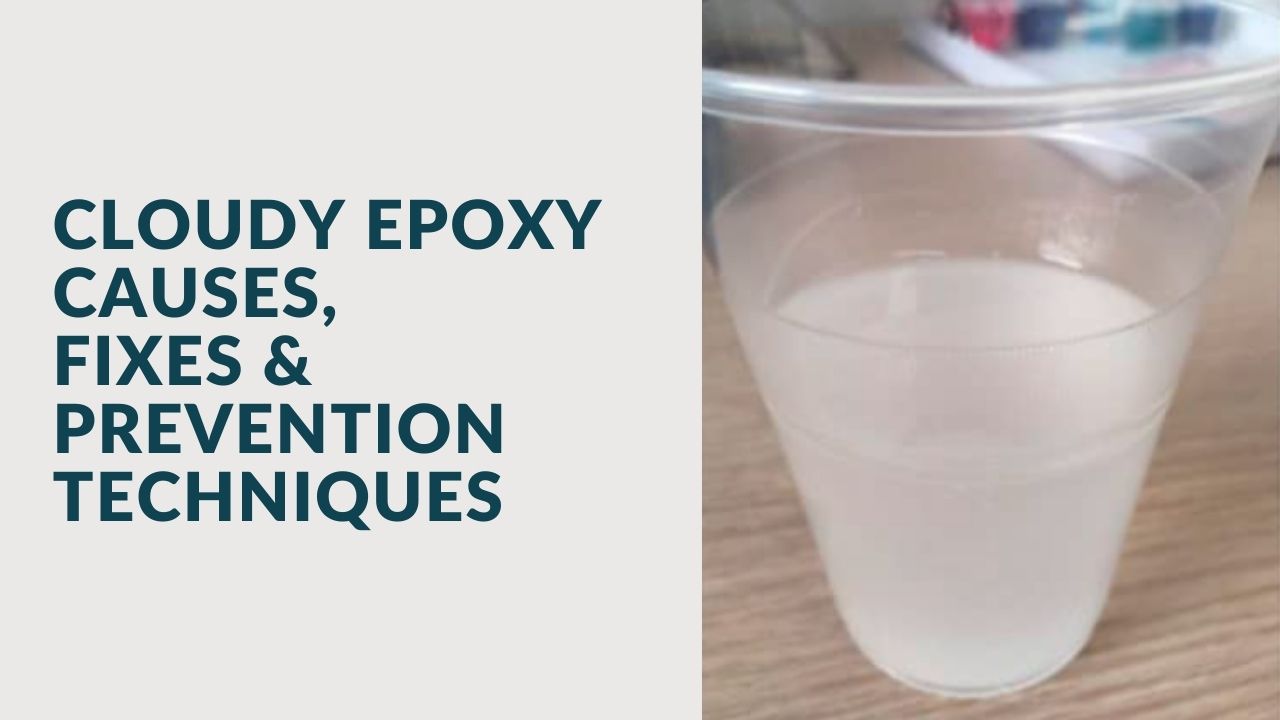Why Is My Epoxy Cloudy
Epoxy is a versatile and durable material used in various applications, from coating surfaces to creating stunning art pieces. However, encountering cloudiness in epoxy can be frustrating and compromise your project's aesthetics and functionality.
Cold temperatures cause the resin to become cloudy due to microbubbles and thick consistency, hindering pouring and mixing.
In this article, we'll delve into the reasons behind cloudy epoxy, how to prevent it, and what steps you can take to fix it. If you need epoxy, visit our epoxy product page.
Causes Of Cloudy Resin
Cloudy resin can be frustrating, especially when expecting a clear and glossy finish for your project. Understanding the various causes behind cloudy resin can help you tackle the problem effectively. Let's delve into some of the most common reasons why resin turns cloudy:
1. Moisture Contamination
Moisture contamination occurs when water or moisture comes into contact with the resin during the mixing or curing. Even small amounts of moisture can disrupt the chemical reaction between the resin and hardener, preventing proper curing and resulting in a cloudy appearance.
This moisture can come from various sources, including high humidity levels in the environment, condensation forming on the surface, or inadequate sealing of the resin container.
Wanna know Is epoxy waterproof or not?
2. Improper Mixing
Proper mixing of resin and hardener is crucial for achieving a clear and uniform finish. Inadequate mixing, such as not blending the components thoroughly or using incorrect proportions, can lead to incomplete curing and cloudiness in the resin.
Following the manufacturer's instructions carefully, including mixing ratios and techniques, is essential to ensure a homogenous mixture.
3. Cold Temperature

Cold temperatures can cause the resin to become cloudy and milky when mixed. This happens because thousands of tiny air bubbles form, which can't be removed using a torch. The cold resin becomes thick and sticky, like taffy, making it hard to pour, mix, and spread smoothly.
Also Read: How To Get a dimple free Epoxy?
4. Contaminated Tools and Materials
Contaminants such as dust, dirt, or residue on mixing tools, molds, or coated surfaces can introduce impurities into the resin, leading to cloudiness.
It's essential to ensure that all tools and materials used in the resin application process are clean and free of contaminants that could affect the final finish. Proper cleaning and preparation of the work area and equipment are critical to prevent contamination.
5. Old or Expired Resin
Using old or expired resin can result in poor curing and cloudiness. Over time, the resin can degrade, affecting its chemical properties and performance. Expired resin may not cure properly, leading to cloudy or tacky finishes. It's essential to check the expiration date of the resin and use fresh materials to ensure optimal results.
6. Chemical Interactions
Certain chemicals or substances present in the environment can react with the resin, causing cloudiness.
This could include exposure to solvents, oils, or other incompatible materials that may come into contact with the resin during application or curing. It's essential to avoid exposing the resin to any substances that could potentially interact with it and cause cloudiness.
7. Incomplete Surface Preparation
Proper surface preparation ensures good adhesion and a clear finish. Failure to clean or degrease the surface before applying the resin can prevent proper bonding and lead to cloudiness.
It's essential to thoroughly clean the surface and remove contaminants or residues that could interfere with the resin's ability to adhere.
8. High Humidity Levels
High humidity levels in the environment can increase the likelihood of moisture contamination and interfere with the resin's curing process.
Moisture in the air can condense on the surface or mix with the resin, preventing proper curing and resulting in cloudiness. Working in a controlled environment with low humidity levels can minimize this risk.
9. Air Bubbles

Entrapped air bubbles in the resin mixture can also contribute to cloudiness, especially if they need to be adequately removed before curing.
Air bubbles can form during mixing or application and become trapped in the resin, creating cloudy areas in the cured finish. Techniques such as vacuum degassing or using a heat gun to remove air bubbles can help achieve a clear and bubble-free finish.
10. Poor Quality Resin
Using low-quality or impure resin can result in cloudiness, as these products may contain additives or impurities that affect the curing process. Choosing a high-quality resin from a reputable supplier is essential to ensure optimal results. Cheaper or inferior resins may not cure properly, leading to cloudiness or other defects in the finish.
I'm sharing a forum with you here, where you can find useful information. Feel free to benefit from this discussion if you're interested.
Solution to Cloudy Resin
To address cloudy resin and achieve a clear and flawless finish for your projects, it's essential to take proactive measures and follow proper techniques during the mixing, application, and curing. Here's a step-by-step solution to prevent cloudiness in resin:
1. Ensure Proper Mixing
Follow the manufacturer's instructions when mixing resin and hardeners. Use precise measurements and mix the components thoroughly for the recommended duration. Avoid whipping or stirring too vigorously to minimize the introduction of air bubbles.
2. Control Cold Temperature
To prevent cold-induced cloudiness in resin, it's crucial to maintain an optimal temperature range of between 23ºC (72ºF) and 30ºC (85ºF). If the resin is colder than this range, gently warm the tightly sealed bottles in a warm water bath until they reach the desired temperature.
However, avoid placing mixed resin and hardener in a water bath to prevent a flash cure. Additionally, store tightly sealed resin and hardener bottles at room temperature.
3. Surface Preparation
Thoroughly clean and degrease the surface before applying the resin to ensure proper adhesion. Remove contaminants or residues that could interfere with the curing process and lead to cloudiness.
4. Minimize Moisture Contamination
Take precautions to minimize moisture contamination during mixing and application. Work in a dry environment with low humidity levels and avoid applying resin in areas prone to condensation.
5. Use Quality Materials
Choose high-quality resin and hardener from reputable suppliers to ensure optimal performance and curing. Avoid using old or expired resin, as it may not cure correctly and could result in cloudiness.
6. Remove Air Bubbles
Before curing, carefully inspect the resin for any air bubbles and remove them using techniques such as gently tapping the surface, using a heat gun, or vacuum degassing. This will help prevent trapped air bubbles from causing cloudiness in the cured finish.
7. Follow Curing Guidelines
Allow the resin to cure for the recommended duration in a clean, dust-free environment. Avoid disturbing the curing process during this time to ensure a smooth and clear finish.
8. Inspect and Polish
Inspect the resin for any cloudiness or imperfections after curing. If cloudiness is present, you may need to sand and polish the surface to restore clarity. Start with a low-grit sandpaper and gradually work up to finer grits for a smooth finish.
for detailed info read our article Get Shine Back On Epoxy?
Tips for Preventing Cloudiness
- Avoid Overheating: Be cautious with resin temperature to prevent premature curing and cloudiness.
- Minimize Air Exposure: Pour resin slowly to reduce bubble formation.
- Use a Heat Gun: Eliminate surface bubbles with gentle heat using a heat gun.
- Cover Work Area: Keep the work area clean and dust-free to prevent contamination.
- Ensure Ventilation: Work in a well-ventilated space to maintain airflow.
- Avoid Direct Sunlight: Cure resin in shaded areas to prevent UV-related cloudiness.
Lastly, I'm providing you with a forum where you can also benefit from discussions on cloudy resin. Feel free to explore and gain insights from the community!
FAQs
How long does it take for epoxy to cure?
Depending on temperature and humidity, epoxy typically cures within 24 to 72 hours.
Can epoxy still cure if it's cloudy?
Yes, epoxy can still cure even if it appears cloudy. However, the cloudiness may persist if the underlying issue still needs to be addressed.
Is cloudy epoxy safe to use?
Cloudy epoxy is generally safe to use, but it may affect the aesthetics and clarity of your project. If in doubt, it's best to sand and polish the epoxy or apply a clear coat for a transparent finish.
Can you add more hardener to cloudy epoxy?
Adding more hardener to cloudy epoxy is not recommended, as it can disrupt the curing process and may not effectively address the cloudiness. It's best to follow proper mixing techniques and surface preparation to prevent cloudiness in the first place.
Can humidity affect epoxy clarity?
Yes, humidity can affect epoxy clarity by introducing moisture into the curing process, leading to cloudiness. Working in a controlled environment with low humidity levels is essential to minimize this risk.
Conclusion
Cold temperatures can lead to cloudiness in resin due to the formation of microbubbles and thick consistency. To prevent this, maintain an optimal temperature range, gently warm resin before use if necessary, and store materials at room temperature. By following these precautions, you can ensure clear and smooth resin finishes for your projects.








